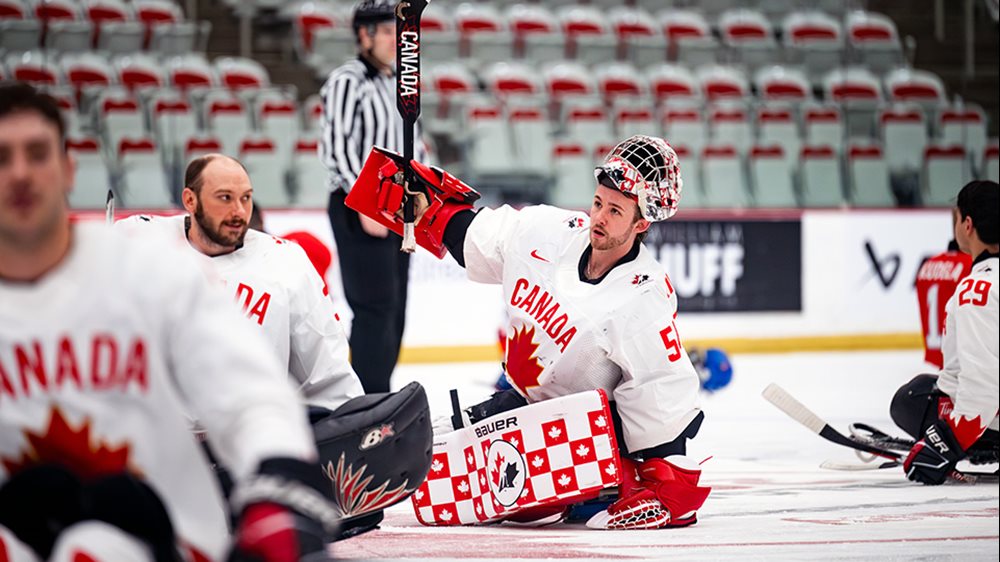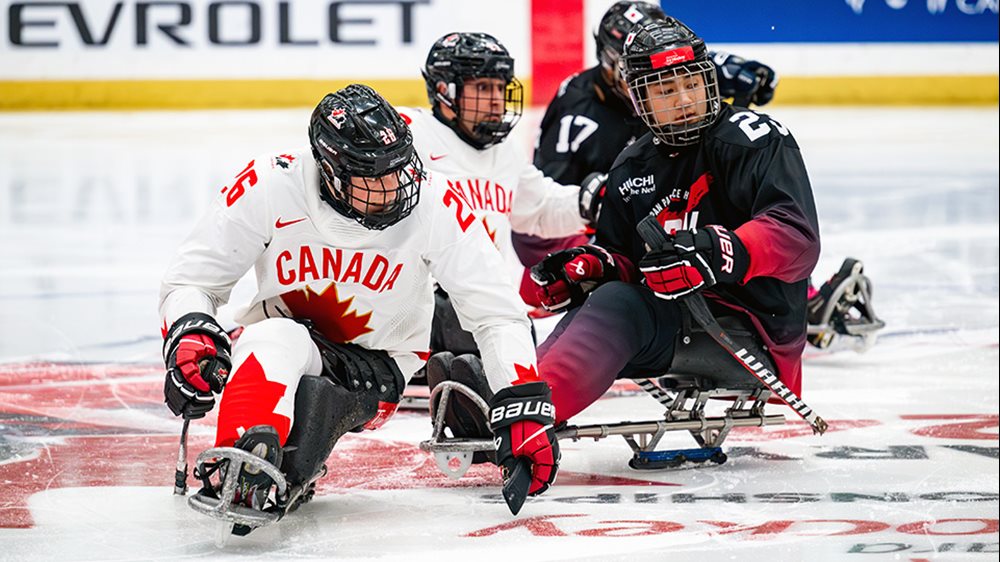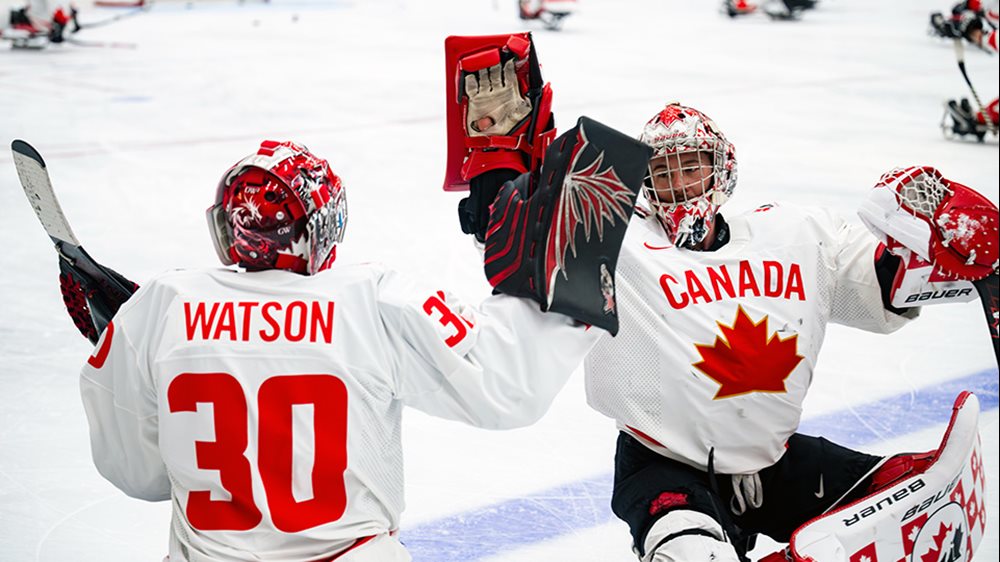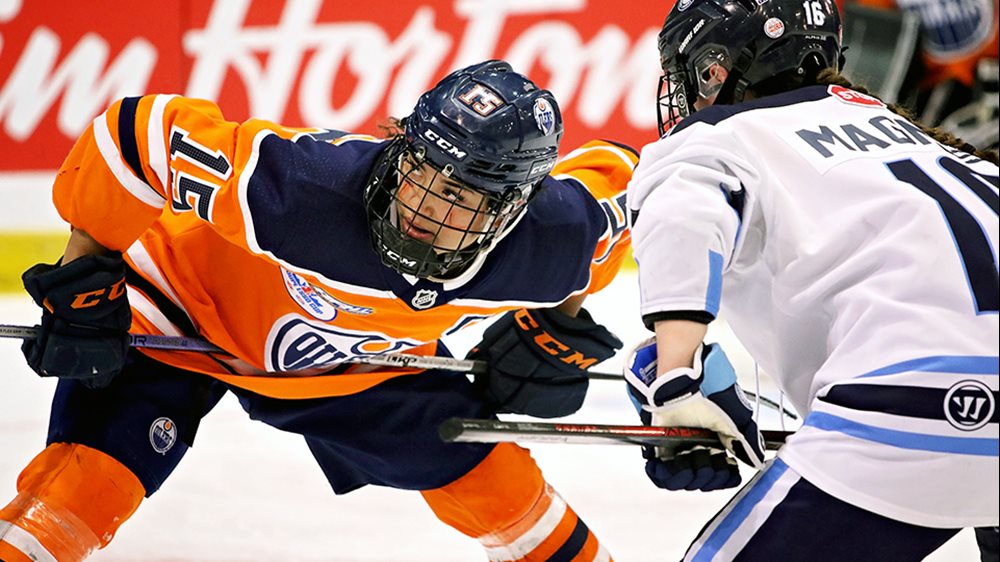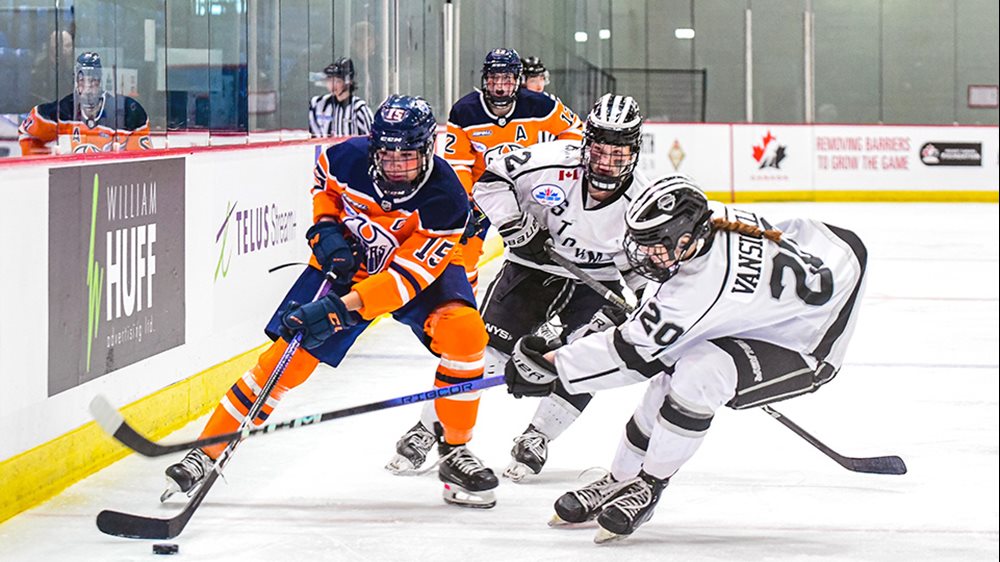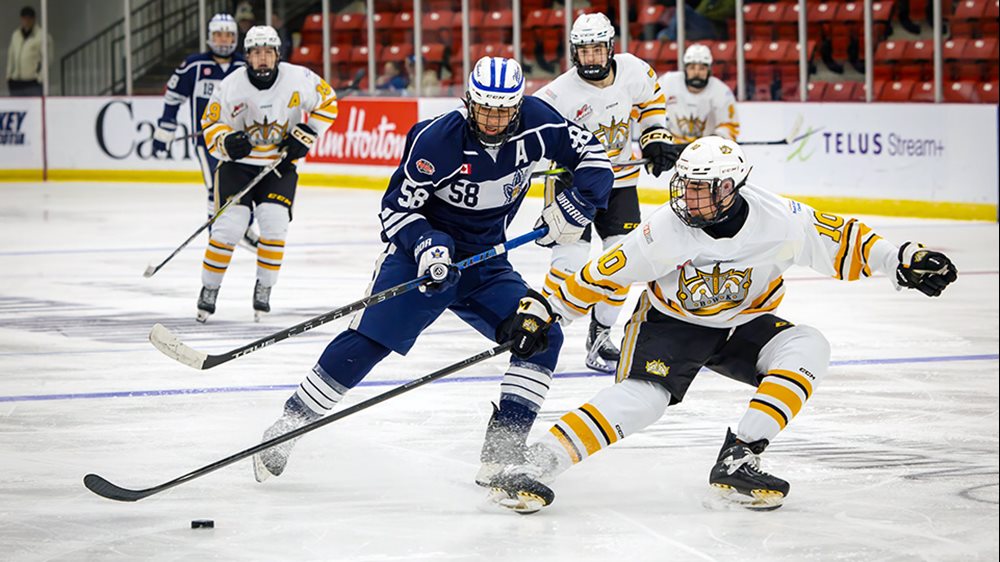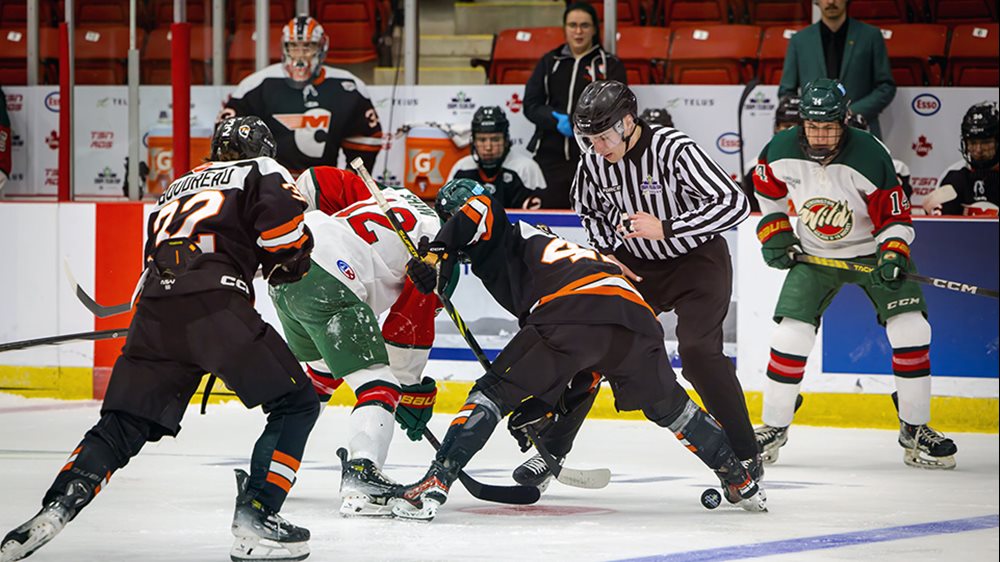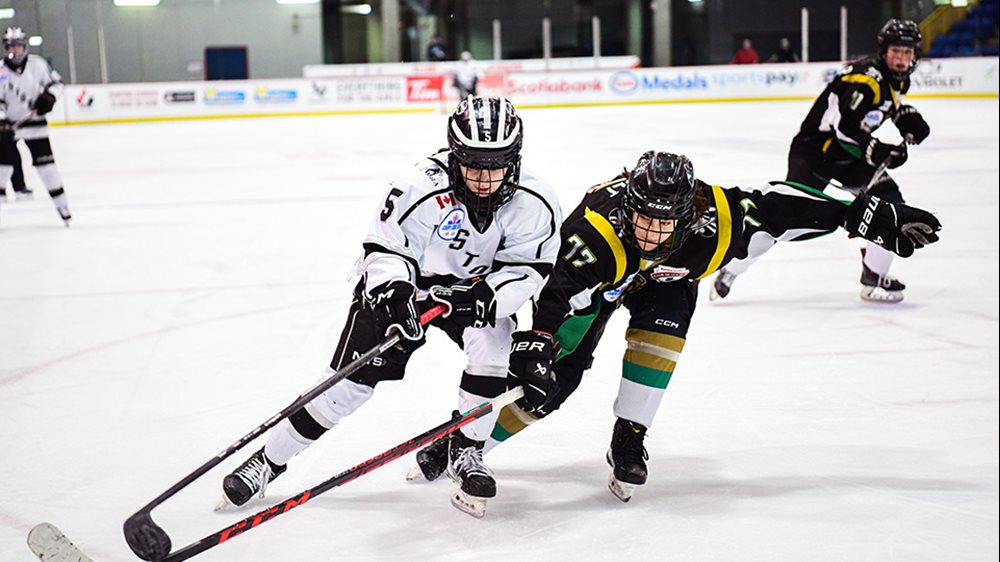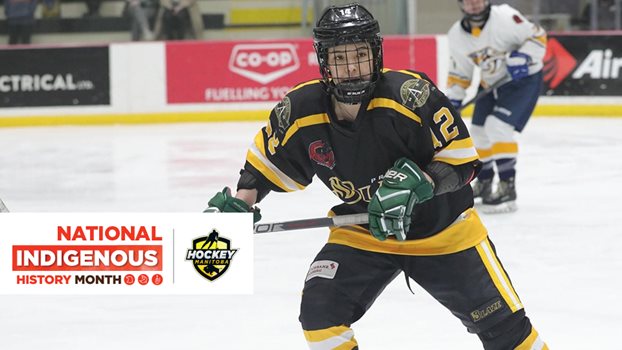
Finding new ways to win
Ready for the next step in her hockey journey, Keyanna Lea is embracing being behind the bench and serving as a role model for young Indigenous players
Keyanna Lea has been doing a lot of winning lately, both on the ice and behind the bench.
The 21-year-old from Berens River First Nation won the Manitoba Women’s Junior Hockey League (MWJHL) championship with the Prairie Blaze this past April and was named playoff MVP after registering 13 points (7-6—13) in eight playoff games.
Just over a month later, Lea was an assistant coach with Team Manitoba as it took home a gold medal at the 2022 National Aboriginal Hockey Championships (NAHC) in Membertou, Nova Scotia. It was Lea’s first time coaching the provincial team after winning back-to-back gold medals as a player in 2017 and 2018.
“It was definitely a different perspective for me. Going back there was an unreal experience because last time I was there I was playing (in 2018) and we won the gold,” Lea says. “It was hard for me to transition with the nerves and the feelings more so because I was feeling what the girls were feeling but as a coach, you don’t want to show the emotions. Being a coach was definitely a humbling experience and let me tell you, being in that gold medal game, it was so hard to be a coach because all you want to do is go out there and play yourself, but the girls made my job easy by doing what was asked of them from the coaching staff.”
Lea’s hockey odyssey has been interesting, to say the least.
After suiting up for the Varsity Prep team at Balmoral Hall in her Grade 11 year in 2016-17, Lea and her twin sister Keyara were approached to move to Boston to play for the Shamrocks in the Junior Women’s Hockey League (JWHL), the same league that Balmoral Hall plays in. Keyanna had a solid 2017-18 season for Boston, scoring 11 goals and adding four assists in 22 games.
Following high school graduation in 2018-19, the sisters were close to committing to play for the University of Manitoba, but they ended up going back to the JWHL to play for the New England Hockey Club.
They returned to Winnipeg after one season in New England and Lea was offered a job as a support worker with Shawenim Abinoojii, a not-for-profit organization in Riverton, Man., that works with First Nations children and families.
She plans on playing one more year with the Blaze, but knows her elite playing days are numbered – hence the transition to coaching.
“After the coaching experience at NAHC, I’ve realized that I do fit in this kind of area so I would love to pursue coaching more. With my job, I’m able to set time aside.” she says.
Lea gives full credit to Dale Bear, her head coach with the Blaze and the long-time head coach of Team Manitoba at the NAHC, for not only encouraging her to pursue coaching, but for the tremendous impact he has had on her hockey career, both on and off the ice.
Lea had previously helped Bear with Team Manitoba tryouts as an on-ice instructor and bench coach, so when he asked Lea to be his assistant coach, the decision to accept was not a hard one.
“Kind of since Day 1, (Dale) has been someone that I have looked up to in terms of him allowing me to be the player that I wanted to be,” Lea says. “He listened to me. He gave me constructive criticism. He gave me the feedback that I needed as a player and as a person. I have always felt close to him. He has always been there for me. It’s hard for me to look at him as a coach because of the things he has done for me in my hockey career and in life. He brought me to my full potential.”
Bear has always seen natural leadership qualities in Lea, which is one of the reasons he nudged her to get behind the bench this past season.
“Keyanna always talked about giving back so I brought up coaching with her and she jumped at the opportunity,” Bear says. “Keyanna displays great leadership when she plays, and that type of leadership is what we want in our coaches that coach in our program. She is very focused, but most of all she has a big heart and knows exactly what is going through these young players' minds, which is a huge benefit for our players and myself having her on the bench.”
Lea has her Coach 1 certification through the National Coach Certification Program, and she plans on obtaining her Coach 2 certification this coming season. She was recently approached to coach a U9 team in Riverton next season.
“I would love to go back home and provide an experience for those young kids like I had,” she says. “Hockey has taken me as a player everywhere, so wherever the coaching may take me, if it’s in the Interlake, in Manitoba, wherever it takes me, I would go.”
To say that hockey has come full circle for Lea would be cliché, but also accurate, as she focuses on the next chapter of her hockey career and giving back to her community.
“Keyanna takes a lot of pride in her Indigenous ancestry and displays hard work and a great attitude,” Bear says. “These traits are exactly what we want to instill in our young Indigenous athletes. In most cases Indigenous players feel left out or intimidated to attend tryouts/camps, but with more Indigenous coaches this will help bring more Indigenous players to programs that didn't really have that diversity on their teams or leagues.”

The power of visibility
A Team Canada alumnus, Isobel Cup champion and transgender advocate, Harrison Browne is using his platform to educate the hockey world and beyond
Hockey provided Harrison Browne with an opportunity to feel openly comfortable. It also granted him a voice to proudly discuss his journey.
Even in retirement, his message and leadership are important and welcomed, likely even more acoustically today than when he played.
“I wouldn’t be where I am today without hockey,” says Browne, a two-time Isobel Cup champion with the Buffalo Beauts of Premier Hockey Federation (PHF). “I wouldn’t be who I am and have the platform I have without hockey.
“Hockey was the first place that I felt comfortable to be myself and a place that I cultivated relationships where I felt supported and could trust people with my identity without judgment.”
As a transgender person and former athlete, Browne appreciates the forum he now possesses to talk, promote – and especially educate – about LBGTQ+ issues and acceptance.
It’s a podium that today permeates beyond hockey and into mainstream society.
“I didn’t set out to be an activist,” he says. “But then I saw the impact of trans visibility and LBGTQ+ visibility and I felt a responsibility to speak out, be vocal and visible to help anybody that can’t be visible like I can.
“I get very protective over my community so, yes, I do now consider myself an activist.”
Since June is Pride Month in Canada and across the world, it is widely used as an opportunity to support and celebrate LBGTQ+ people through parades, dances, festivals and other events.
For Browne, Pride Month is all of that and more.
“It’s about celebrating how far we’ve come and recognizing how far we need to go,” says the Toronto resident. “June is a great reminder of how strong this community is and how supportive we all are of each other.
“And it’s a great way to celebrate who you are as a person.”
Growing up in Oakville, Ont., Browne began playing hockey when he was nine years old, a “geriatric start” to the sport in his own words.
Regardless of when it commenced, it concluded as a solid career that lasted 16 years and included playing for Team Canada at the 2011 IIHF World Women’s U18 Championship and four years of college hockey in the United States, the last three on scholarship at the University of Maine.
From there, his time in the professional ranks stretched over three seasons in the PHF (known then as the National Women’s Hockey League), two with Buffalo and a final campaign in 2018 with the Metropolitan Riveters prior to retirement.
During his entire professional career, he was the first openly transgender athlete in a team sport.
Now 29, Browne has shifted his focus to public speaking and a vibrant acting career, both of which are conduits for trans and LBGTQ+ visibility and advocacy.
“I’ve been very fortunate,” he says. “After I retired from the game, I’m still a voice that people look to in the hockey community. I kind of meshed it with my acting. To be able to have those two worlds align, I certainly feel like I have a voice. And it’s something that I don’t take lightly and I’m very proud of.”
Browne’s appearances include celebrity hockey games and functions, keynote speeches, Scotiabank television commercials and an appearance in an episode of The Last Man, a TV drama series based on the comic book set by the same name.
By his own admission, Browne’s new career and schedule doesn’t permit much time for recreational hockey, something he laments.
However, he will always cherish the game for what it provided prior to his coming out, but especially after he did in 2016.
He said the PHF, its fans and teammates were extremely supportive during his social transition in what also became a pivotal period for LBGTQ+ inclusion in sports.
“They all helped me embrace who I am,” says Browne. “When I came out through hockey, I felt being visible helped a lot of people and the hockey community really helped me.”
Browne believes women’s hockey has been instrumental in inclusiveness, acceptance and a beacon for other sports to follow in pursuit of LBGTQ+ visibility and equality.
“The women’s side is exemplary on how other sports and society as a whole can include the LBGTQ+ community and celebrate people for their differences,” he says. “And to look at people simply as teammates.”
What does concern Browne in this month of celebration are some additional barriers that restrict further progressive movement for the LBGTQ+ community.
The recent influence of “non-inclusive” bills and legislation across North America has created some deep concerns.
In some jurisdictions these laws or bans specifically hinder younger LBGTQ+ people from playing sports and that is a step backwards in our society, according to Browne.
“It’s unfortunate that it comes with people having to fight back, but I have seen a lot of progress in the last five years.
“We’re in a moment right now where we’re fighting for our place, but I do see a lot of hope.”

The importance of orange
The Orange Jersey Project is using the power of sport to educate young players about residential schools and strengthen the path towards truth and reconciliation
While Canada today recognizes the third annual National Day for Truth and Reconciliation to honour the children, survivors, families and communities affected by residential schools, the day has long held significant meaning for the Indigenous community.
Since 2013, Sept. 30 has been Orange Shirt Day, which was started by residential school survivor Phyllis Webstad. She wore an orange shirt on her first day at the St. Joseph’s Mission Residential School in the fall of 1973, which was taken from her by staff.
“The color orange has always reminded me of … how my feelings didn’t matter, how no one cared and how I felt like I was worth nothing. All of us little children were crying and no one cared,” Webstad shared at OrangeShirtDay.org.
Webstad launched the Orange Shirt Society “to be able to tell my story so that others may benefit and understand, and maybe other survivors will feel comfortable enough to share their stories.”
Last year, the Orange Shirt Society expended into the sporting community with the creation of the Orange Jersey Project, with Webstad’s son, Jeremy Boston, serving as project manager. According to the website, the project was born out of an idea – “What if we could use the power of sport to serve as a vehicle toward educating today’s young athletes about the history of the Indian Residential School System and strengthen the path toward truth and reconciliation with Indigenous Peoples.”
As part of that education, each jersey features a QR code that links to an online platform that will help children discover the history of residential schools, with the goal to encourage learning, engagement, sharing and activities.
The project began with hockey jerseys during the 2021-22 season, more than 20,000 of which have been distributed to hundreds of teams from coast to coast to coast over the last two seasons.
Last season, the Orange Jersey Project partnered with the Western Hockey League (WHL), with all teams wearing a special WHL Truth and Reconciliation logo in early October 2022. (Teams will do so again this season, beginning today.) In addition, 11 teams wore special-edition orange jerseys during warmups prior to games in February 2023, which were later auctioned off.
At the conclusion of the campaign, $22,500 was donated to the Orange Jersey Project, funds that will go towards providing more minor hockey teams with their own orange jerseys.
On the National Day for Truth and Reconciliation, HockeyCanada.ca caught up with Boston to discuss the Orange Jersey Project, continuing his mother’s passion project and what the future holds.
Where did the idea for the Orange Jersey Project come from?
The Orange Jersey Project was created by Tyler Fuller, an Indigenous male from Kawacatoose First Nation in Saskatchewan who played pro hockey in the Central Hockey League (CHL) and International Hockey League (IHL). The idea of the Orange Jersey Project was born from an idea that came while Tyler and his wife Amanda were watching the news when the remains of the 215 children who were students of the Kamloops Indian Residential School in Tk’emlúps te Secwépemc were uncovered.
Tyler and Amanda came up with the idea to design a hockey jersey as a way to inform people about residential school survivors and victims. Tyler contacted Chief Willie Sellars of Williams Lake First Nation and asked for his guidance. Chief Sellars directed Tyler to Phyllis Webstad, the founder of the Orange Shirt Society, who introduced Tyler to the OSS executive director, who helped get the ball rolling.
Why was it important for the Orange Shirt Society to expend into sports?
Sports, such as hockey, are a great vessel for all Indigenous and non-Indigenous to come together to learn the real history of Canada. The Orange Shirt Society is designed to encourage action for truth and reconciliation and can help educate athletes about the history of the residential school system in Canada. The Orange Shirt Society works to create awareness of the intergenerational impacts of residential schools and the concept of Every Child Matters.
Why is this project important to your family and to the Indigenous community?
Four generations of my family have attended residential schools. My great-grandmother Lena Jack, my grandmother Rose Wilson and my mother Phyllis Webstad attended residential schools. I attended the last operational school in Canada in 1996. It is important for the path of healing and new beginnings in a Canada we all love. To overcome barriers between Indigenous and non-Indigenous to become one and come together as we continue to educate and learn together on our path for truth and reconciliation.
How can interested teams get their orange jerseys?
Beginning today, teams can visit OrangeJerseyProject.ca to register and request orange practice jerseys, as well as the curriculum program, at no cost, while supplies last.
Once teams have received their jerseys, they’re encouraged to choose several practices throughout the season dedicated to wearing the jerseys and spending a few minutes acknowledging the Treaty Lands upon which they are playing and the Indigenous Peoples who reside there. We also invite teams to participate in team-building activities off the ice to work through the curriculum together.
Hockey was first … which sports are next?
Currently our main focus is hockey, but we are planning to expand into other sports beginning sometime in 2024.
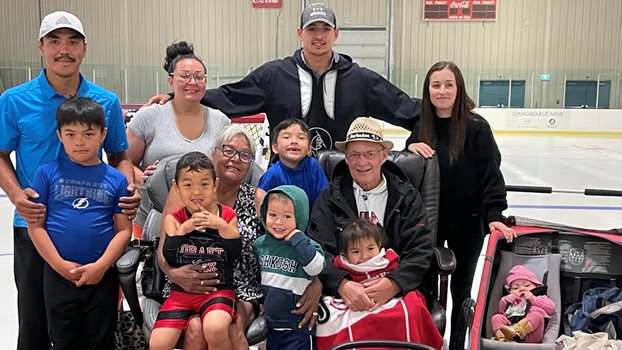
Leaving a lasting impression in the North
Tommy Williams left behind an impact on the Northwest Territories through his love for his family, the game of hockey, his Métis heritage and trying to make a difference for Indigenous youth
Tommy Williams was a man of the people in the Northwest Territories. Not only in his various roles throughout a long career in government, but also at the hockey rink.
“He was an amazing man … so passionate about the game and he really put his heart into hockey,” says Pamela Williams, Tommy’s wife of 32 years. “He cared so much about people, and he wanted to teach every kid the love he shared for the game and the joy of the sport.”
Williams died last August at 60 years old, after a battle with cancer. He left an impact on the community through his love for his family, the game of hockey, his Métis heritage and trying to make a difference for Northern youth.
He was a goaltender for 48 years, playing until he no longer physically could, even after getting knee and hip replacements.
His daughter Aurora always remembers him being involved in hockey from an early age.
“He coached me throughout my childhood, and he was always a favourite coach for the players,” she says. “He was a fun guy and made friends everywhere around the rink. Everyone respected him and he had a big impact on all of us.”
His passion for hockey was obvious to his family, including Pamela. Being at the rink is what made Tommy happy – it didn’t matter if he was playing, coaching or just watching games.
“He wanted to be a professional hockey player and he would always spend any free time at the rink,” Pamela says. “He played in rec leagues and old-timer leagues and would watch his kids and grandkids play at home and away at tournaments in different cities.”
Tommy played at different levels, reaching the Western Hockey League with the Medicine Hat Tigers as the back-up to former NHLer Kelly Hrudey. He enjoyed his time, but always felt pulled to the North and how he could grow the game and support Indigenous Peoples in his own community.

“He played such an important role model for so many Indigenous youth. He was proud of who he was, and he could connect and understand what those kids were going through,” says Aurora. “The kids he coached over the years still share how much of an impact he had on them.”
James easily fell into his dad’s footsteps with an early love for the game. He was coached from a young age by his dad, and he learned a lot about the game – on and off the ice – from him and used those lessons as he continued his playing career.
James left home at age 14 to play Junior A hockey in Summerside, P.E.I., with the Summerside Western Capitals of the Maritime Hockey League. He played a couple years of university hockey as well before returning home for good, but continued to play in the same recreational leagues his dad used to play in.
“He always wanted what was best for me and my sister,” James says. “When I moved away and felt homesick, he pushed me to do my best and he believed in me. Now that I’m back in Inuvik, I play in the same leagues he used to, and people still know who he was and what he meant to the hockey community.”
Like his dad, James had the opportunity to coach Team NWT at the Canada Winter Games in 2023, something his dad did in 2007.
Tommy was a person that easily made connections with people, particularly through the national game. One year, when no one stepped up to coach a U18 team, Tommy agreed to take the reins.
“This is one of my favourite stories about my dad,” James says. “He did what no one else wanted to do and those kids grew up to be leaders in their communities. He was proud to be Indigenous and he wanted to provide opportunities for others in the North.”
When Tommy died, those players shared with the Williams family how he helped them off the ice as much as he did on it.
The impact Tommy left on the community is vast. On top of being the president and CEO of the Northwest Territories Housing Corporation, he also opened a sports equipment store in Inuvik so more Indigenous youth could get involved in hockey. He never believed that just because a family couldn’t afford to play shouldn’t mean they couldn’t play, and helped create a fund to help cover fees for players.
“He just wanted kids from the North to have the same advantage as the kids in the south,” says James. “He was a public servant by trade, and he understood that role, but he also understood the need to give back through sports.”
Before he died, the community honoured Tommy for his contributions to the game by retiring his Mad Trappers jersey at the Ed Jeske Olympic Arena in town, a moment that meant a lot to the Williams family.
“He was so honoured and emotional to see that recognition,” Aurora says. “I still get emotional when I go to the rink and see his jersey. We are all so proud to see that recognition.”
Hockey will always be a part of their lives as James, Aurora and her husband Bryon all play in the rec leagues in Inuvik, and four of Aurora’s children play. Knowing how much Tommy loved the game, they want to continue to carry his legacy for their kids, but also youth in their communities.
“He was a wonderful man that shared his passion of hockey with everyone,” Pamela says. “He was taken way too soon, but we had a good life.”
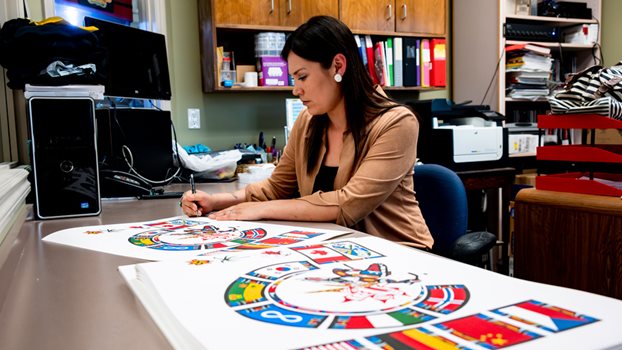
Celebrating unity with Indigenous art
The Player of the Game award for the 2023 World Para Hockey Championship is a limited-edition piece of artwork created by local Indigenous artists
A representation of unity will be front and centre during the 2023 World Para Hockey Championship thanks to a collaboration between two local Indigenous artists.
Brandy Jones is an Inuit artist who moved to Regina from British Columbia when she was 12 years old. Her work involves mixed mediums of native arts, representing unity among all Indigenous peoples. Rodger W. Ross is of Métis/Cree descent and a member of the George Gordon First Nation in Saskatchewan. He is a multi-disciplined artist and an international award-winning documentary film producer, whose career spans four decades.
Read on to learn more about Player of the Game artwork. Answers have been slightly edited for clarity and length.
Hockey Canada (HC): How did this collaboration come together for the 2023 World Para Hockey Championship?
Rodger Ross (RR): I've worked with the Moose Jaw Warriors in the past. I did a cultural presentation to them first, and then I created an orange shirt design for them. When the situation came up with the World Para Hockey Championship, one of the ladies that I worked with reached out and gave my information. […] Seeing how Brandy’s [art form] works so well for these forms, it just seemed like a perfect collaboration. So, when I was asked [who I would recommend], she was the first name [I suggested].
Brandy Jones (BJ): Rodger has always been a very big
support of my work. Not just on giving me advice, but sometimes when it
comes to collaboration with the work as well, there's things that he sees in
my work as I'm going along. He has a very good eye for it. For example, in
the hockey helmet, at first it was connected to the feather that was
attached there. And he was like, “You should put a white line to separate
that.” That's something that I hadn't even seen yet. I'm always willing to
work with Rodger because he always has the coolest jobs… I'm always very
happy to oblige.
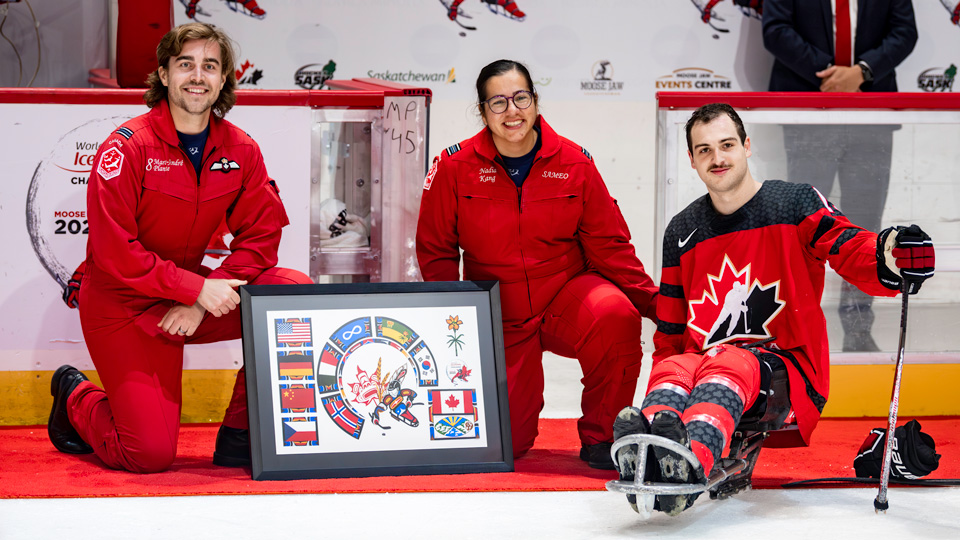 Captain Marc-André Plante and squadron aircraft maintenance engineering officer Nadia Kang of the Canadian Forces Snowbirds present Dominic Cozzolino with the player of the game award on May 29, 2023.
Captain Marc-André Plante and squadron aircraft maintenance engineering officer Nadia Kang of the Canadian Forces Snowbirds present Dominic Cozzolino with the player of the game award on May 29, 2023.
HC: What is the inspiration behind the design of the Player of the Game artwork?
RR: When we first got approached, I wanted to know more about the game because I haven't watched a lot of [para hockey]. But I've watched some para hockey, and I'm so impressed by it, because I'm a former hockey player as well. […] When I'm watching these players and how they move, the power that they have and that constant flow of energy, that to me had to be the centerpiece. […] The first thing I wanted was that hockey player in the middle, and I wanted that movement because Brandy’s art form works with that movement so well. And then I thought the best way to have the country's representatives is through their flags. […] Having the Métis flag, the Saskatchewan flag, the Treaty 4 flag, obviously the Canada flag is represented in the logo itself—to me, those seemed like the natural elements.
BJ: I think it's perfect the way that it came out. It’s the design for me that just feels like it represents Canada.
HC: Brandy, you also created another artwork for event stakeholders. What was the inspiration behind that piece?
BJ: It's a Thunderbird. Sometimes it's hard for people to decipher that type of work. Some people see it right away, and then other times people are looking in there thinking, “What is that?” That is something that Rodger and I had discussed. We had looked at the Four Directions and what represented each of those directions. For me, I really tried hard to mix those animals together. But I was finding that very hard to do at the time. I tried to just look at what I thought was the most powerful out of all four of those. I did add a bear in there as well, within the body. But for some reason, it was the Thunderbird that really stuck out to me, because there are bringers of the thunder. It’s kind of as simple as that it, it was the animal that I thought was the most powerful and stood out the most to represent what we were doing at the time.
HC: This is the first time the World Para Hockey Championship has been hosted in Canada. How does it feel knowing your contribution will be associated with the legacy of the event?
BJ: That’s so hard to answer because it just feels really incredible. There's no other way to describe it other than that; it's beautiful being able to represent like my country and also the province that I live in. It was definitely a labour of love, and I could not be happier.
RR: For me, it's always about relationships, and as far as Indigenous inclusion, any time that that I get invited to allow our voices to be heard, to allow our people to be represented, it's always going to be a great honour. But I also look at it as an obligation to reconciliation. […] It makes me feel very, very proud to be able to participate at this level, to be in an international event, and to be a part of that. For Brandy and I to be invited to hand out that award between the United States and Canada, with the world watching, I think is a pretty powerful statement of, “We haven't gone anywhere, and we're not going anywhere,” We're here, and we have beautiful cultures among us. It’s time that our voices be heard.
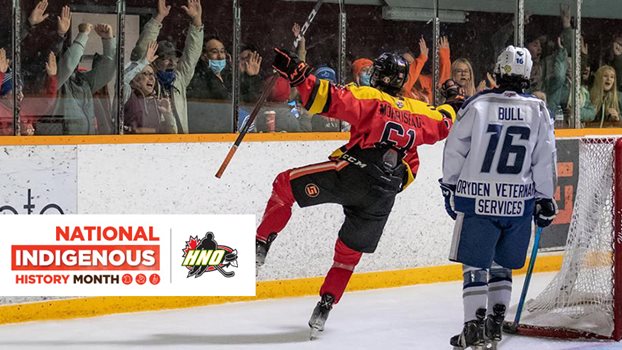
Fighting Walleye celebrate Indigenous culture
The Kam River Fighting Walleye hosted their first-ever Orange Wave Night to celebrate Indigenous culture and raise money for post-secondary scholarships
Trenton Morriseau says games like the Orange Wave Night are special, but he knows healing — and growth — when it comes Indigenous relations in Canada is a process.
Morrisseau’s junior hockey team — the Kam River Fighting Walleye of the Superior International Junior Hockey League (SIJHL) — hosted the inaugural Orange Wave Night on March 12 at Norwest Arena in Oliver Paipoonge, Ont., which celebrated Indigenous culture and traditions.
Members of the Fighting Walleye wore one-time orange design jerseys, sponsored by Jason Thompson and his company, Warrior Supplies and Engineering. The colour orange has become a symbol of the Indigenous movement. According to the team, the mission is to “celebrate diversity, promote cultural awareness and support the Indigenous community through sport.”
The game-worn jerseys were auctioned off and the money raised – more than $10,000 – went towards post-secondary scholarships for graduating Indigenous players.
Nineteen-year-old Morriseau, who was born and raised in Fort William First Nation, says the hard work by everyone in the Walleye organization and the sponsors to put this event together will go a long way.
“It’s really important to celebrate our culture with our community of Oliver Paipoonge,” he says. “You know, it’s just the step in the right direction for reconciliation and healing for Aboriginal people.”
While Morriseau is in his second year with the Walleye, a franchise started in 2020, this campaign was his first full one with the club after a large part of the 2020-21 season was cancelled due to the COVID-19 pandemic.
Morriseau is a graduate of the Thunder Bay Kings AAA program who finished the 2021-22 season ninth in SIJHL scoring with 21 goals and 29 assists.
He admits he would be lying if he didn’t encounter prejudice while moving up the hockey ladder.
“At some point, every Indigenous person is going to experience some kind of racism,” says the 5-foot-10 forward. “It’s our job to try and educate people and you know, tell them like what’s right. And it’s not their fault, what they hear at home from their parents and stuff either, right? So lots of times, they’re just good kids, and they’re just kind of repeating what they hear at home. You know what I mean? So it’s just it’s our job to educate them. We just have to keep that in mind.”
The opening ceremony of Orange Wave Night included an Indigenous drum group featuring Ron Kanutski, the Fort William First Nations Little NHL Team and special dignitaries within the community.
Dignitaries consisted of Aaron Kakapetum (senior commercial account manager of Indigenous banking, RBC); Trevor Iserhoff (director of inclusion and diversity, SIJHL); Colin Campbell (co-owner, Kam River Fighting Walleye); Jason Thompson (owner and founder, Warrior Supplies and Engineering); Chief Peter Collins (Fort William First Nation); Grand Chief Derek Fox (Nishnawbe First Nation); and Beatrice Hynnes (Ojibway anthem singer).
The Fighting Walleye capped off the celebratory evening with a win, coming from behind to down the visiting Dryden Ice Dogs 3-2 thanks to a game-winner from Morriseau with just 3:45 left.
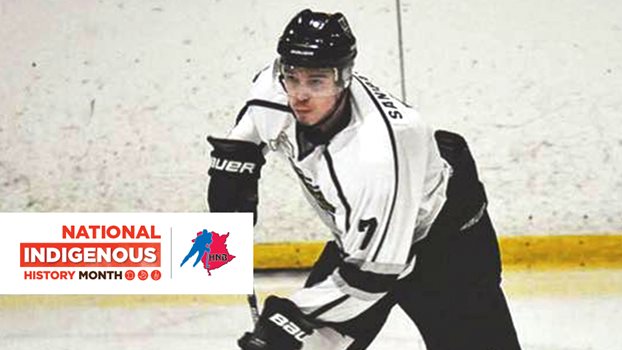
An opportunity to represent
Through the Aboriginal Apprentice Coach Program, Creighton Sanipass has a chance to coach at the 2023 Canada Games and serve as a role model for young Indigenous athletes
As a hockey player, Creighton Sanipass often noticed a lack of Indigenous representation in the game. As a coach, he hopes to do something about it.
Through the Aboriginal Apprentice Coach Program, Sanipass is part of the New Brunswick coaching staff for the 2023 Canada Winter Games.
He wants to serve as a role model for young Indigenous athletes who may have had similar experiences with underrepresentation.
“I hope that Indigenous athletes see that there are opportunities to get involved and help the future generation of athletes get the chances that they rightfully deserve,” says Sanipass. “I am proud to be Mi’kmaq. Our culture has a history with the sport and it’s not just by chance that Indigenous hockey players feel so comfortable on the ice – it’s in our blood.”
Sanipass learned to skate at the age of two and began playing minor hockey at four. His father, Everett, played 164 NHL games during a six-year pro career and represented Canada at the 1987 IIHF World Junior Championship, so hockey was always a part of his life. The 6-foot-2 forward played in the Maritime Hockey League (MHL) with the Valley Wildcats and St. Stephen County Aces and in the New Brunswick Junior Hockey League (NBJHL) for the Tri-County River Cats, finishing with 21 points in 21 games in his final season.
Now, learning a different side of the game as a coach, he’s honoured to be participating in the program and wants others to do the same.
“I hope that more Indigenous coaches become involved and become a face for Indigenous hockey players to look up to and strive to be,” he says.
In addition to his role on New Brunswick’s U16 team, Sanipass was also part of the coaching staff with Team Atlantic at the National Aboriginal Hockey Championships in Nova Scotia in May.
Off the ice, Sanipass is a university student majoring in criminology and works for Aboriginal Sport and Recreation New Brunswick.
“I’ve always wanted to have a job where I could help give opportunities to Indigenous youth that weren’t around when we were young,” he says. “Seeing Indigenous youth thrive makes it all worthwhile.”
It will be his first time attending the Canada Games, and he is excited to experience all the event has to offer, including the mentorship he’s receiving from more established coaches.
The Aboriginal Apprentice Coach Program provides up to two coaches per Canada Games from each province and territory the opportunity to develop their coaching skills. The program’s objectives include building coaching capacity within Aboriginal communities and providing coaches with professional development and learning opportunities for high-level coaching.
Sanipass will continue to absorb all he can on the road to Games, which are scheduled for Feb. 18 to March 5 across P.E.I., and beyond. He credits the sport with teaching him invaluable life skills and hopes he can pass that wisdom on to future players.
“I want to be an example. You can take everything that you have learned through your experiences and give back to the next generation. Up-and-coming athletes deserve the opportunities that might not have been around when we were younger, and we can be the reason that they are able to fulfill their potential.”

Motivated to make a difference
Proudly Indigenous, Victoria Bach is embracing her roots and giving back, all while keeping focused on her Olympic opportunity
Victoria Bach doesn’t have a lot of free time these days.
In addition to her activities with the Professional Women’s Hockey Players’ Association (PWHPA), Bach is working towards her professional master’s degree in education at Queen’s University and, not least of all, preparing to chase a gold medal at the 2021 IIHF Women’s World Championship and a roster spot for the 2022 Olympic Winter Games.
Who says life is boring during a global pandemic?
But in recent months, another task has taken centre stage in Bach’s life – working with Indigenous communities across the country.
A proud member of the Mohawks of the Bay of Quinte First Nation near Belleville, Ont., the 24-year-old is driven by the memory of her late grandmother as she looks to give back.
Happy National Indigenous Peoples Day! Especially to this strong woman. Miss you everyday Grandma. I am proud to be indigenous! 🤍 pic.twitter.com/urbadYopVI
— Victoria Bach (@veebach21) June 21, 2020
“My grandmother, Shirley, was born and raised in Tyendinaga,” Bach says. “She's always been a big role model to me, hearing her stories, what [she went] through throughout her life. It's been really inspiring to me.”
To help reach a larger audience, Bach has connected with ProPacts, a group that works with athletes (its roster includes Hockey Hall of Fame member Brian Trottier and two-time Olympic gold medallist Shannon Szabados, among others) to create interactive and engaging events.
“I've given a bunch of different presentations on life skills,” she says. “And I've also been [doing] workouts. [It is about] being a good role model and having kind of a mentorship program.”
It’s not a one-way street, however. As much as those on the other side of the screen get from Bach, she is getting just as much from them, asking questions to help round out her understanding of Indigenous culture.
Bach did not grow up on the reserve, and relied on stories from her grandmother and father to truly embrace her Mohawk roots and trace the journey of her family.
“I haven't had the chance to experience that culture,” she says, noting she is also taking classes with an Indigenous focus at Queen’s. “It’s important to learn the history, the hardships, the different languages and everything that goes into being Indigenous.”
And if everything goes her way, she’ll have an awfully large platform to tell her story in the next eight months.
Bach is one of 28 players who have been selected to centralize with Canada’s National Women’s Team ahead of the 2022 Olympic Winter Games. From that group, 25 will be chosen to wear the Maple Leaf at women’s worlds in Calgary beginning Aug. 20.
She has been along for the rollercoaster ride that has been the women’s hockey world in the last 16 months – the 2020 women’s worlds were cancelled in the early days of the pandemic, and the Province of Nova Scotia pulled the plug on the 2021 tournament in April, just two weeks out from the first games – but it appears puck drop is set for the Stampede City.
“We're all so excited to get to Calgary and get to compete and play games and play for that world championship,” the Boston University product says. “It's something that we've been waiting for the past year and a half, to get that opportunity. And it's finally coming closer.”
Bach was a standout with Canada’s National Women’s Development Team, posting 33 points in 35 games from 2015-18 before making her National Women’s Team debut at the 2018 4 Nations Cup.
She has scored four times in 15 games with the senior team, including a memorable overtime winner against the U.S. in the Rivalry Series in February 2020, just weeks before COVID-19 shut down the world.
🚨 @katbt617 knocks, lets @veebach21 do the honours of opening the door. VICTORIA WINS IT IN VICTORIA❗️#RivalrySeriespic.twitter.com/UpUiMg0kar
— Team Canada Women (@HC_Women) February 4, 2020
The upcoming women’s worlds is just step one. As soon as the gold medals are awarded in Alberta, the focus immediately shifts to Beijing and the six-month journey that is Olympic centralization.
“We're there to compete as a group and get better as a group,” Bach says. “After the world championship is over, a new chapter begins. And we push ourselves and push our teammates. I'm really excited to just get the chance to compete every day with one another. I think it's going to be a great experience.”
With so much on the go, Bach could be excused for not having just a single end goal in mind. But it all comes back to who she is, where she comes from and what she represents.
“I hope to be a role model for all those young Indigenous girls and boys, and someone that they can look up to.”

Power skills, power people
A hockey camp created by Wacey Rabbit and supported by the Indigenous Sport Council of Alberta is giving Indigenous kids a place to be kids
Hockey and community have always gone hand-in-hand for Wacey Rabbit. He remembers getting to the rink for one of his first practices was a family effort.
“My mom didn’t know how to put on my equipment, and I had a 6 a.m. practice, so we had to drive 20 minutes to my grandparents’ place,” Rabbit laughs. “So, I’m sitting there watching Saturday morning cartoons and eating my cereal while my grandparents are showing my mom how to put my equipment on.”
Those memories full of family and friends are the foundation on which Rabbit’s love for the game was built. The 34-year-old just finished his 15th season as a professional, the last three-and-a-half with the Jacksonville Icemen in the ECHL. But his experiences within the game didn’t always match his positive outlook. Rabbit remembers the first time he was exposed to racist and derogatory comments at the rink as a 10-year-old playing in his first major tournament away from the Kainai First Nation in southern Alberta.
“I remember talking to my parents and grandparents about it and my grandma said, ‘It’s not a reflection on you, it’s a reflection on them for what they’re saying. You be proud of who you are, and you be proud of where I come from.’ And I’ve taken those words with me everywhere I go,” Rabbit says.
“I’m a very proud First Nations man. I come from the Blood Tribe, I’m Blackfoot. For me to say those things and recognize those things, I hope that the next generation is proud that they can chase their dreams whether it’s on reserve or off reserve, whether it’s in academics, sports, whatever it is, whatever their passion is, that they believe in themselves to go and chase that.”
Rabbit is trying to support at least some of the dreams of Indigenous youth, by creating the WR20 Power Skill Hockey Camp and touring it around Alberta. (He has plans to take his camps to First Nations throughout the country when it is safe to do so.)
“We’re just trying to get the game out there and the wellness of sports and living healthy,” Rabbit explains. “Especially with COVID, you could see how hard it was on some of the younger kids … it was important that, even if it was just for an hour a day, these kids got to go on the ice and just be kids to help with their mental health.”
While some locations had to be moved or ice times adjusted to meet public health protocols, Rabbit managed to host camps in Kainai, Siksika and Frog Lake First Nations. At each stop, he recruited other Indigenous professional players to help, including Devin Buffalo.
“Just seeing him work with the kids in Frog Lake, you could tell, a lot of coaches don’t have that connection with the youth,” Buffalo says. “I was able to learn from him, to remember that for the youth, hockey is fun and to keep it fun not to make it too serious, and sometimes it is OK to make hockey playful and play games and just keep things light and fun.”
Captain Indigenous from Frog Lake First Nation WR20 Power Skill Youth Hockey Camp. Day 2 let’s roll ! pic.twitter.com/AE23yROvNf
— Wacey Rabbit (@WaceyRabbit20) October 31, 2020
Growing up, Buffalo says he knew Rabbit had a very successful junior career in the Western Hockey League (including a Memorial Cup in 2007 with the Vancouver Giants) and had gone on to play professionally, but didn’t really get to know him personally until they were both in the ECHL. With similar experiences in their past, Buffalo says Rabbit naturally became a mentor for him and has been a huge support in his own post-playing career, creating goalie camps focused on the development of Indigenous netminders.
“ [Now I’m] passing that on, creating players that are not just great hockey players but great people and students in the classroom,” says Buffalo, who earned a political science degree at Dartmouth College while playing for its men’s hockey team.
In addition to running his own camps, Buffalo works with the Indigenous Sport Council of Alberta. He says it was a great decision by the executive committee to name Rabbit a hockey ambassador for the Council.
“He was definitely someone who had all the attributes we were looking for in an ambassador and just the way he responds to the kids and all the kids he does work with have glowing reviews, so I think it was an easy decision,” Buffalo explains.
“Hockey is my passion, but my people are the most important thing for me – my family,” Rabbit says. “Hopefully in 10 years there’s a hundred kids in the NHL and we see a First Nations kid playing for the (Maple) Leafs, finally giving them their [Stanley] Cup, but he’s the captain raising the banner; that’s what I want for the next generation.”
Rabbit laughs while making the joke about the 54-year drought for the Leafs, but keeps smiling thinking about the possibilities for his people.
“For our next generation, I just want to make sure it’s an easier transition for them to get into sports, because at the end of the day sports is about community. It’s about coming together; it’s about having fun … so it’s about building community in sports. I think that’s the most important part.
“Everybody has a voice; everybody has a right to go play and feel like they’re accepted.”
More information on WR20 Power Skill Youth Hockey Camps can be found by following Wacey Rabbit on Instagram @wr20powerskills , and check out WaniskaMentality.com for more information about Devin Buffalo’s goaltender camps.

An eye for talent
Trevor Iserhoff has a unique scouting role with the Kam River Fighting Walleye, scouring First Nations communities from coast to coast to coast
A few years ago, Kevin McCallum was on the road in northern Ontario during a scouting trip.
“I was working up at a previous job at Cat Lake, and the guy that drove me around pointed to a house and said ‘There’s a 17-year-old living there that’s the best skater I’ve ever seen in my life,’” says McCallum. “And there was no one really there to spot him.”
Today, McCallum is the general manager of the Kam River Fighting Walleye of the Superior International Junior Hockey League, a Junior A loop that operates in Ontario, Minnesota and Wisconsin.
He shares that story when asked how much talent there is in First Nations communities throughout Ontario and, really, throughout Canada. He’s a believer that many parts of the country have never been scouted well and teams are missing out.
“I have seen a ton of great players who are uncoached but have that talent that’s there,” McCallum says. “If we can identify them a lot earlier and guide them in the process, hopefully we can get them either into a Walleye uniform or even on to something bigger and better.”
The Fighting Walleye are entering their second SIJHL season, although their expansion campaign lasted just four games thanks to the COVID-19 pandemic.
Since the club entered the league, identifying and recruiting talent in First Nations communities has been a priority; it is so important, in fact, that one of McCallum’s initial staff hires was Trevor Iserhoff, who was given the title of First Nations scout. Iserhoff, originally from Moose Factory, Ont., played a lot of his minor hockey in Thunder Bay and area and went on to play junior hockey in Ontario, Saskatchewan and Manitoba, along with a stint south of the border in the United States.
After his junior hockey career came to an end, he played senior men’s hockey and then moved on to coaching his own kids in the game. Now, his role sees him work with contacts throughout the country to find players from First Nations communities who have what it takes to play at the Junior A level.
“I was fortunate enough to play with a lot of good hockey players and now they live throughout Canada,” says Iserhoff. “So I’m able to contact them and see if they know of anyone that has the caliber to play junior hockey. With social media, I have people coming up to me and asking, ‘Is this kid good enough to play?’ It’s a lot of social media work, just contacting people and them contacting me. I know people from Nova Scotia all the way to B.C. who are helping me out with this. It’s not just me doing it. I have a lot of help.”
Iserhoff is modest, but the work he’s putting in for the Fighting Walleye is noteworthy and impressive. His background – having grown up in a First Nations family, his path to junior hockey, his knowledge of the game – is an incredible asset for the Kam River club.
They’re also important when he visits a family of a young hockey player and talks to them about the benefits of joining the Fighting Walleye.
“It’s very important for parents to trust. You’re sending your son to live in a totally different city and meet new people,” says Iserhoff. “Me, talking to parents to try and sell the idea for their son to play junior hockey goes a long way. Having those contacts that are reaching out to me, to back me up and say, ‘Yeah, this is good for your son’ and ‘Yes, your son can play junior hockey.’
“Some communities are maybe 500 to 1,000 people and then if you go to a city like Thunder Bay, it’s over 110,000 people, so you really get a culture shock and brand-new surroundings. So it will take time to get used to. Once you do get used to it, you’re going to have the time of your life playing junior hockey.”
The Fighting Walleye currently have 11 players on their active roster who come from First Nations communities. The club is holding a prospects camp in late August and are expecting players from northern Ontario and as far away as Nunavut.
Iserhoff, who hosts a podcast called Rez Hockey where he interviews First Nations players and shares their stories, is blazing a trail that he hopes many others will take as he knows there’s talent out there.
“I hope so, I hope it becomes a trend because there’s enough talent for a lot of junior teams to have First Nations kids on their teams,” he says. “I’m humbled to be the first one in Canada but I was able to have a lot of mentors and people I looked up to in hockey so I think it’s my turn to pay back what I was taught and who I learned from.”
For more information: |
- <
- >
















